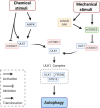Mechanobiology of Autophagy: The Unexplored Side of Cancer
- PMID: 33718218
- PMCID: PMC7952994
- DOI: 10.3389/fonc.2021.632956
Mechanobiology of Autophagy: The Unexplored Side of Cancer
Abstract
Proper execution of cellular function, maintenance of cellular homeostasis and cell survival depend on functional integration of cellular processes and correct orchestration of cellular responses to stresses. Cancer transformation is a common negative consequence of mismanagement of coordinated response by the cell. In this scenario, by maintaining the balance among synthesis, degradation, and recycling of cytosolic components including proteins, lipids, and organelles the process of autophagy plays a central role. Several environmental stresses activate autophagy, among those hypoxia, DNA damage, inflammation, and metabolic challenges such as starvation. In addition to these chemical challenges, there is a requirement for cells to cope with mechanical stresses stemming from their microenvironment. Cells accomplish this task by activating an intrinsic mechanical response mediated by cytoskeleton active processes and through mechanosensitive protein complexes which interface the cells with their mechano-environment. Despite autophagy and cell mechanics being known to play crucial transforming roles during oncogenesis and malignant progression their interplay is largely overlooked. In this review, we highlight the role of physical forces in autophagy regulation and their potential implications in both physiological as well as pathological conditions. By taking a mechanical perspective, we wish to stimulate novel questions to further the investigation of the mechanical requirements of autophagy and appreciate the extent to which mechanical signals affect this process.
Keywords: autophagosome; biomembranes; cytoskeleton; mechanosensing; mechanotransduction.
Copyright © 2021 Hernández-Cáceres, Munoz, Pradenas, Pena, Lagos, Aceiton, Owen, Morselli, Criollo, Ravasio and Bertocchi.
Conflict of interest statement
The authors declare that the research was conducted in the absence of any commercial or financial relationships that could be construed as a potential conflict of interest.
Figures




Similar articles
-
Mechanobiology in cardiac mechanics.Biophys Rev. 2021 Aug 27;13(5):583-585. doi: 10.1007/s12551-021-00827-4. eCollection 2021 Oct. Biophys Rev. 2021. PMID: 34765042 Free PMC article.
-
The matrix environmental and cell mechanical properties regulate cell migration and contribute to the invasive phenotype of cancer cells.Rep Prog Phys. 2019 Jun;82(6):064602. doi: 10.1088/1361-6633/ab1628. Epub 2019 Apr 4. Rep Prog Phys. 2019. PMID: 30947151 Review.
-
Multiscale Mechanobiology in Brain Physiology and Diseases.Front Cell Dev Biol. 2022 Mar 28;10:823857. doi: 10.3389/fcell.2022.823857. eCollection 2022. Front Cell Dev Biol. 2022. PMID: 35419366 Free PMC article. Review.
-
Roles of the cytoskeleton, cell adhesion and rho signalling in mechanosensing and mechanotransduction.J Biochem. 2017 Mar 1;161(3):245-254. doi: 10.1093/jb/mvw082. J Biochem. 2017. PMID: 28082721 Review.
-
Mechanism and Regulation of Autophagy in Cancer.Crit Rev Oncog. 2018;23(5-6):269-280. doi: 10.1615/CritRevOncog.2018028394. Crit Rev Oncog. 2018. PMID: 30311560 Review.
Cited by
-
Advances towards the use of gastrointestinal tumor patient-derived organoids as a therapeutic decision-making tool.Biol Res. 2023 Dec 2;56(1):63. doi: 10.1186/s40659-023-00476-9. Biol Res. 2023. PMID: 38041132 Free PMC article. Review.
-
Do Tumor Mechanical Stresses Promote Cancer Immune Escape?Cells. 2022 Nov 30;11(23):3840. doi: 10.3390/cells11233840. Cells. 2022. PMID: 36497097 Free PMC article.
-
The Autophagic Route of E-Cadherin and Cell Adhesion Molecules in Cancer Progression.Cancers (Basel). 2021 Dec 16;13(24):6328. doi: 10.3390/cancers13246328. Cancers (Basel). 2021. PMID: 34944948 Free PMC article. Review.
-
The Role of Mechanotransduction in Contact Inhibition of Locomotion and Proliferation.Int J Mol Sci. 2024 Feb 10;25(4):2135. doi: 10.3390/ijms25042135. Int J Mol Sci. 2024. PMID: 38396812 Free PMC article. Review.
-
Exploiting Matrix Stiffness to Overcome Drug Resistance.ACS Biomater Sci Eng. 2024 Aug 12;10(8):4682-4700. doi: 10.1021/acsbiomaterials.4c00445. Epub 2024 Jul 5. ACS Biomater Sci Eng. 2024. PMID: 38967485 Free PMC article. Review.
References
Publication types
LinkOut - more resources
Full Text Sources
Other Literature Sources

